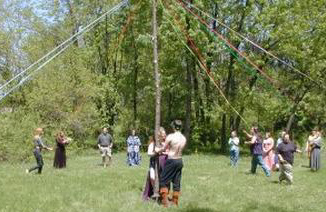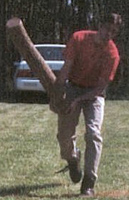








































|
 |

The Wheel of the Year: High Holy Days
ADF Groves celebrate the 8 Neo-Pagan High Days: Samhain, Winter Solstice,
Imbolc, Spring Equinox, Beltaine, Summer Solstice, Lughnassad, and Autumnal
Equinox. The following description of those High Days is accompanied by a
rundown of the Neo-Pagan mythology surrounding the Wheel of the Year for
clarification of why things would be done in a "modern" context.
Samhain is the end of the old year, and the beginning of the new.
This is the time when the veil between the worlds is thinnest. This
festival was celebrated in Celtic cultures as the final harvest, the
last feast before the winter famine. Often, it is associated with the
Feast of the Dead, where ancestors are remembered and asked to join in
the festivities. I often make extra portions of food for the dead, and set the
table for those guests that have died in the past year.
Samhain is usually a time to take stock of what is going on in your life
and to begin new things. Things associated with the old year are honoured,
then thrown out. This might be reflected in the dealings with the dead on
this day.
The dead should be honoured, but also removed. At the end of the period we
celebrate Samhain in, we should remove the dead from our presence. The dead
should not be allowed to linger, for it is not proper.
In Neo-Pagan myth, the God dies at Samhain, symbolizing the reaping
of the harvest. The God is sacrificed (or dies) at the end of the feast,
and with his death, the world goes into a deathlike slumber. This may be
tied to the mourning of the Goddess Demeter in Greek mythology, though if
it is, the tie is very indirect. In Neo-Pagan myth, the Goddess mourns
the death of her son and lover, while in Greek myth, Demeter mourns for her
daughter, who will return in 6 months.
The Celts did not really celebrate this Holy Day, and its later celebration
probably came from Norse contact, where 12 days of Yule were celebrated.
Rituals done at this time should probably be done to bring the Sun back, since
until this day, the sun has been waning and is now showing nine and a half hours
of light. The ancients, while they may have known that the Sun would return,
likely did rituals of some sort to ensure the process.
This is a time of conception, a time when we should begin to lay the foundings
of things we want to happen. Usually, plans should be made for the future, and
a special focus should be on what will come in the following warmer months. Tied
to this, September is a common month for children to be born.
In Neo-Pagan myth, the God is conceived (some say born, in which case he both
dies and is conceived at Samhain) on the Winter Solstice. The symbolism is obvious
when you compare the God to the Sun, which appears reborn from the darkness at this
point.
In Ireland, it is around this time of year when the livestock begin to give
birth, and the ewes begin to lactate again. The ice and snow begins to melt and
the days start their climb to warmer temperatures, echoing the lactation that
figures so prominently into ancient mythologies. This is a fertility festival,
and shows the triumph over winter.
The modern folktale that if a groundhog sees his shadow on Feb. 2 is tied to this
as well. There is a certain amount of fear that this winter is going to last much
longer than we are prepared. In the ancient world, food was in short supply at this
time, and the new birth and lactation signaled the continuance of the cycles.
Looking at Norse myth, we see that this is the time of year that the Norse were
assured that the Nagalvinter (three consecutive winters) had not come this year.
There is likely to be a certain amount of fear and axiety at this ritual, and
worries about the coming spring not occuring are likely high.
In Neo-Pagan myth, it usually represents the birth of the God, and the closest
depiction to the relationship between Goddess and God at this point would be the
Madonna and Child representations the Catholic Church uses. The Goddess is still
a maiden figure, but she cares for the child who will grow to be her husband one
day.
The Spring Equinox is the beginning of the Light half of the year, since this is
where the light portion of the day exceeds 12 hours. The veil of winter is officially
lifted, and a time of honouring the Gods who have sustained us through the winter.
Late spring plantings begin at about this time.
Personally, I don't find this particular High Day speaking to me much. It's a day that's
neither long nor short, and I suppose that that makes it an interesting liminal time,
but there's little else that I feel for it.
In Neo-Pagan myth, the God begins to court the Goddess at this point.
 Beltaine is the beginning of Summer and the end of planting season. It is
also the beginning of the season of war, and fires figure heavily into the festival.
Fertility is paramount at this point, as all the fields have been planted and the
Spring storms are ending. The only thing left for an agrarian community to do until
harvest is pray that the year is a good one. Often, this is the time that couples
decide to marry or have children, in a sense hoping that their own fertility will
transfer to the land. Beltaine is the beginning of Summer and the end of planting season. It is
also the beginning of the season of war, and fires figure heavily into the festival.
Fertility is paramount at this point, as all the fields have been planted and the
Spring storms are ending. The only thing left for an agrarian community to do until
harvest is pray that the year is a good one. Often, this is the time that couples
decide to marry or have children, in a sense hoping that their own fertility will
transfer to the land.
This is one of the major fire festivals of the Celts, and is generally seen as the
second most important festival (next to Samhain). Often, a maypole is set up which
symbolizes fertility as a phallic symbol. The maypole has a series of ribbons
which are each held by a participant, and the men dance one way and the women
another. The twining of their ribbons is symbolically the twining of their
bodies and the creation of fertility.
Neo-Pagan myth places the marriage of the God and Goddess at this point in the
year. Many Neo-Pagans use Beltaine as their own date for marriage.
The Summer Solstice is the height of the Solar year, and is the beginning of the
descent into darkness. Here again, we have a holiday that wasn't really
celebrated by the Celts.
Neo-Pagan myth has the God being at his strongest at this point, and the next
festival is the beginning of his descent.
 This festival is the time of the first harvests, and the celebration of the games
in honour of the God Lugh, commemorating his mother. These are displays of strength
and skill designed to be a final fling before the weather turns colder. A
potential parallel may be seen in the Olympic Games of Greece, where we find the
idea that by the act of exertion the Gods are praised. This festival is the time of the first harvests, and the celebration of the games
in honour of the God Lugh, commemorating his mother. These are displays of strength
and skill designed to be a final fling before the weather turns colder. A
potential parallel may be seen in the Olympic Games of Greece, where we find the
idea that by the act of exertion the Gods are praised.
This holiday also falls in the middle of the hottest part of the summer, and as
such is the festival where we ask to be delivered from the heat. If the heat
continues to wax, then crops are lost and drought is usually the worst at this
time.
In Neo-Pagan myth, Lughnassad often symbolizes the strength of the marriage
between the God and Goddess.
This Equinox represents the beginning of the dark half of the year. The harvests
are entering the middle stages, and the temperatures are dropping. All around, death
is becoming noticeable, from the trees to the disappearance of the animals going into
hibernation.
Recently, it has become associated with memorializing and preparing closures for
me. This feeling dates back about two years to the 9-11 attacks on the WTC. It
isn't really associated with anything in the Celtic calendar as far as we can
see, so I'm using it the way that fits best with my modern usage.
In Neo-Pagan myth, the God is dying, and the Goddess is getting old. This is the
end of His life, and He becomes a dark, underworld God.
Questions, Comments, or Concerns? Email
me!
Back to the Dedicant's
Index.
Content © 2003, Michael J Dangler
Updated on 02/18/2003. Site Credits / Email Me!
Basic site design from ADF.org
(Yes, I stole it!)
|


 Beltaine is the beginning of Summer and the end of planting season. It is
also the beginning of the season of war, and fires figure heavily into the festival.
Fertility is paramount at this point, as all the fields have been planted and the
Spring storms are ending. The only thing left for an agrarian community to do until
harvest is pray that the year is a good one. Often, this is the time that couples
decide to marry or have children, in a sense hoping that their own fertility will
transfer to the land.
Beltaine is the beginning of Summer and the end of planting season. It is
also the beginning of the season of war, and fires figure heavily into the festival.
Fertility is paramount at this point, as all the fields have been planted and the
Spring storms are ending. The only thing left for an agrarian community to do until
harvest is pray that the year is a good one. Often, this is the time that couples
decide to marry or have children, in a sense hoping that their own fertility will
transfer to the land. This festival is the time of the first harvests, and the celebration of the games
in honour of the God Lugh, commemorating his mother. These are displays of strength
and skill designed to be a final fling before the weather turns colder. A
potential parallel may be seen in the Olympic Games of Greece, where we find the
idea that by the act of exertion the Gods are praised.
This festival is the time of the first harvests, and the celebration of the games
in honour of the God Lugh, commemorating his mother. These are displays of strength
and skill designed to be a final fling before the weather turns colder. A
potential parallel may be seen in the Olympic Games of Greece, where we find the
idea that by the act of exertion the Gods are praised.